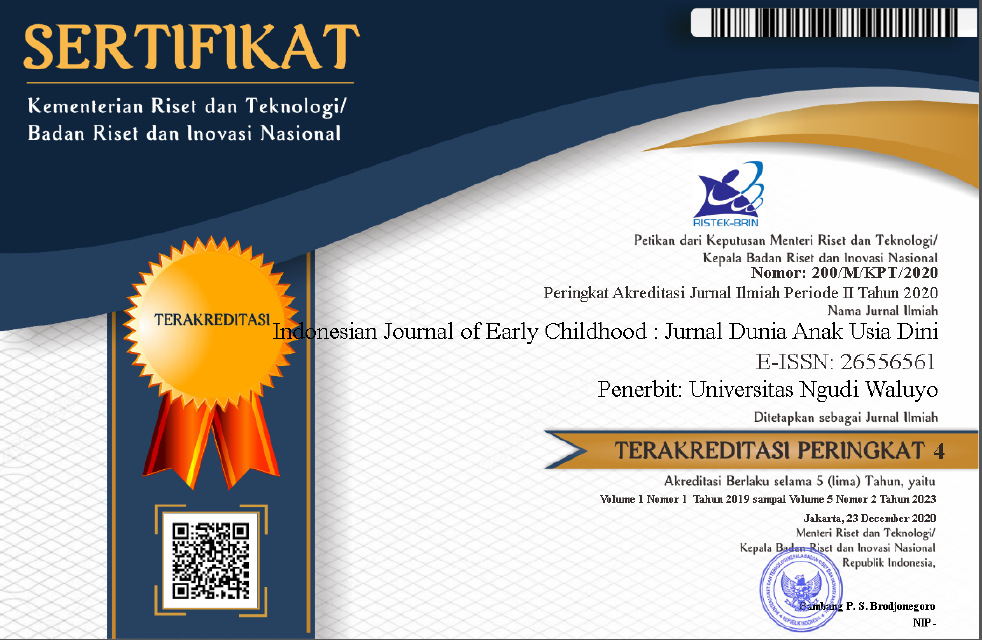Pengembangan Media Pembelajaran Video Interaktif Table Manner untuk Meningkatkan Perilaku Makan bagi Disabilitas Intelektual
The Development of Interactive Video Learning Media on Table Manners to Improve Dining Behavior for Individuals with Intellectual Disabilities
DOI:
https://doi.org/10.35473/ijec.v7i1.3613Keywords:
Media pembelajaran, Video interaktif, Table manner, Perilaku Makan, Disabilitas IntelektualAbstract
This study aims to develop an interactive video-based learning media on table manners specifically designed to improve dining behavior among individuals with intellectual disabilities. The media is tailored to individual needs by integrating visual, auditory, and simple interactive elements suitable for the learners’ abilities. The research employs the ADDIE development model (Analysis, Design, Development, Implementation, and Evaluation), which includes needs analysis, media design, prototype development, implementation with participants, and effectiveness evaluation. The trial results indicate that the interactive video effectively helps participants understand fundamental concepts of proper dining behavior, such as using utensils, appropriate seating, and table etiquette. Improvements in dining behavior were observed through pretest and posttest measurements, showing significant positive changes among participants. The media also received positive feedback from teachers and parents, who noted that the video provides an engaging and easy-to-understand learning experience for learners. Therefore, this media demonstrates potential as an inclusive and effective learning tool to support life skills development for individuals with intellectual disabilities.
ABSTRAK
Penelitian ini bertujuan untuk mengembangkan media pembelajaran berupa video interaktif bertema table manner yang dirancang khusus untuk meningkatkan perilaku makan bagi penyandang disabilitas intelektual. Media ini dirancang dengan pendekatan berbasis kebutuhan individu, menggabungkan elemen visual, audio, dan interaksi sederhana yang sesuai dengan kemampuan peserta didik. Metode penelitian menggunakan model pengembangan ADDIE (Analysis, Design, Development, Implementation, and Evaluation) yang mencakup analisis kebutuhan, perancangan media, pengembangan prototipe, implementasi pada peserta didik, dan evaluasi efektivitas. Hasil uji coba menunjukkan bahwa video interaktif ini efektif dalam membantu peserta didik memahami konsep dasar perilaku makan yang baik, seperti penggunaan alat makan, tata cara duduk, dan etika saat makan. Peningkatan perilaku makan diamati melalui pengukuran pretest dan posttest, dengan hasil signifikan pada perubahan perilaku positif peserta didik. Media ini juga mendapatkan respons positif dari guru dan orang tua yang menilai bahwa video memberikan pengalaman belajar yang menarik dan mudah dipahami oleh peserta didik. Dengan demikian, media ini berpotensi menjadi alternatif pembelajaran yang inklusif dan efektif untuk mendukung pengembangan keterampilan hidup bagi penyandang disabilitas intelektual.
References
Akmal, N., Putri, Y. E., & Anugerah, A. I. (2022). Developing adobe animate-based interactive learning media of table manner for university students. International Journal for Educational and Vocational Studies, 4(3). https://doi.org/10.29103/ijevs.v4i3.9336
Damastuti, E. (2020). Pendidikan Anak dengan Hambatan Intelektual. Kalimantan selatan: prodi PLB FKIP ULM
Dehghan, M., & Mente, A. (2021). Associations of unprocessed and processed meat intake with mortality and cardiovascular disease. American Journal of Clinical Nutrition, 114(3), 1049-1058. https://doi.org/10.1093/ajcn/nqaa448
Ghosh Dastidar, M., et al. (2019). "Food Environment, Dietary Behavior, and Health Outcomes: A Literature Review." Journal of Health & Social Behavior, 60(1), 53-67. https://doi.org/10.1177/0022146518812685
Hidayat, F., & Muhamad, N. (2021). “Model Addie (Analysis, Design, Development, Implementation and Evaluation) Dalam Pembelajaran Pendidikan Agama Islam Addie (Analysis, Design, Development, Implementation and Evaluation) Model in Islamic Education Learning”. J. Inov. Pendidik. Agama Islam, 1(1), 28-37.
Hutabarat, J., Siallagan, M.T., Sianipar, N., Kabeakan, N., & Widiastuty, M. (2022). “Meningkatkan Kemampuan Daya Ingat dan Kelambanan Berpikir Pada Siswa Berkebutuhan Khusus (Tunagrahita Kelas C) Di SLB N. Siborongborong”. Jurnal Pendidikan Sosial Dan Humaniora, 1(4), 200–2013.
Nurhidayati, I. 2020. Analisis Muatan Kemampuan Berpikir Tingkat Tinggi Berdasarkan Karakteristik Peserta Didik Tunagrahita Pada Buku Teks Kurikulum 2013 Kelas IV SDLB.
O'Neil, H. F., et al. (2014). Technology in Education: Tools for Learning. Springer. https://doi.org/10.1007/978-1-4614-6435-8
Piziak, V. (2014). The development of a bilingual interactive video to improve physical activity and healthful eating in a head start population. International Journal of Environmental Research and Public Health, 11(12), 13065-13073. https://doi.org/10.3390/ijerph111213065
Sobal, J., & Nelson, M. K. (2003). Commensal Eating Patterns: A Community Study. Appetite, 41(2), 181-190. https://doi.org/10.1016/S0195-6663(03)00078-3
Sugiyono. 2015. Metode Penelitian Kuantitatif, Kualitatif, dan R&D. Bandung : ALFABETA
Sukmawati, Retno Sri Lestari, Thresia Dewi K. B., & Siti Saharia Rowa. (2021). Table Manner. Makassar: Politeknik Kesehatan Kemenkes Makassar. Diakses pada 14 Oktober 2024, dari https://e-modul.poltekkes-mks.ac.id/file/modul/gizi/table-manner.pdf.
Van Strien, T. (2018). "Causes of emotional eating and matched treatment of obesity." Current Diabetes Reports, 18(1), 4. https://doi.org/10.1007/s11892-017-0893-3
Vaughan, M. (2011). Storytelling in Educational Technology. Wiley. https://doi.org/10.1002/978111917498
Ward, P. L., & Schmitt, N. J. (2018). The impact of technology in education: A cross-national study. Journal of Educational Technology & Society, 21(4), 91-101. https://doi.org/10.1007/10.1080/20402355.2018.1475349
Zepeda, S. J., & Deal, T. E. (2020). Educational Leadership: Context, Strategy, and Perspective. Routledge. https://doi.org/10.4324/9780429029809
Downloads
Published
How to Cite
Issue
Section
License
Copyright (c) 2025 Indonesian Journal of Early Childhood: Jurnal Dunia Anak Usia Dini

This work is licensed under a Creative Commons Attribution-ShareAlike 4.0 International License.
Please find the rights and licenses in Indonesian Journal Of Early Childhood: Jurnal Dunia Anak Usia DIni. By submitting the article/manuscript of the article, the author(s) agree with this policy. No specific document sign-off is required.
1. License
The non-commercial use of the article will be governed by the Creative Commons Attribution license as currently displayed on Creative Commons Attribution-ShareAlike 4.0 International License.
2. Author(s)' Warranties
The author warrants that the article is original, written by stated author(s), has not been published before, contains no unlawful statements, does not infringe the rights of others, is subject to copyright that is vested exclusively in the author and free of any third party rights, and that any necessary written permissions to quote from other sources have been obtained by the author(s).
3. User Rights
Indonesian Journal Of Early Childhood: Jurnal Dunia Anak Usia Dini's spirit is to disseminate articles published are as free as possible. Under the Creative Commons license, Indonesian Journal Of Early Childhood: Jurnal Dunia Anak Usia Dini permits users to copy, distribute, display, and perform the work for non-commercial purposes only. Users will also need to attribute authors and Indonesian Journal Of Early Childhood: Jurnal Dunia Anak Usia Dini on distributing works in the journal and other media of publications.
4. Co-Authorship
If the article was jointly prepared by more than one author, any authors submitting the manuscript warrants that he/she has been authorized by all co-authors to be agreed on this copyright and license notice (agreement) on their behalf, and agrees to inform his/her co-authors of the terms of this policy. Indonesian Journal Of Early Childhood: Jurnal Dunia Anak Usia Dini will not be held liable for anything that may arise due to the author(s) internal dispute. Indonesian Journal Of Early Childhood: Jurnal Dunia Anak Usia Dini will only communicate with the corresponding author.
5. Miscellaneous
Indonesian Journal Of Early Childhood: Jurnal Dunia Anak Usia Dini will publish the article (or have it published) in the journal if the article’s editorial process is successfully completed. Indonesian Journal Of Early Childhood: Jurnal Dunia Anak Usia Dini's editors may modify the article to a style of punctuation, spelling, capitalization, referencing and usage that deems appropriate. The author acknowledges that the article may be published so that it will be publicly accessible and such access will be free of charge for the readers as mentioned in point 3.
Â
Every accepted manuscript should be accompanied by "Copyright Transfer Agreement" prior to the article publication.



